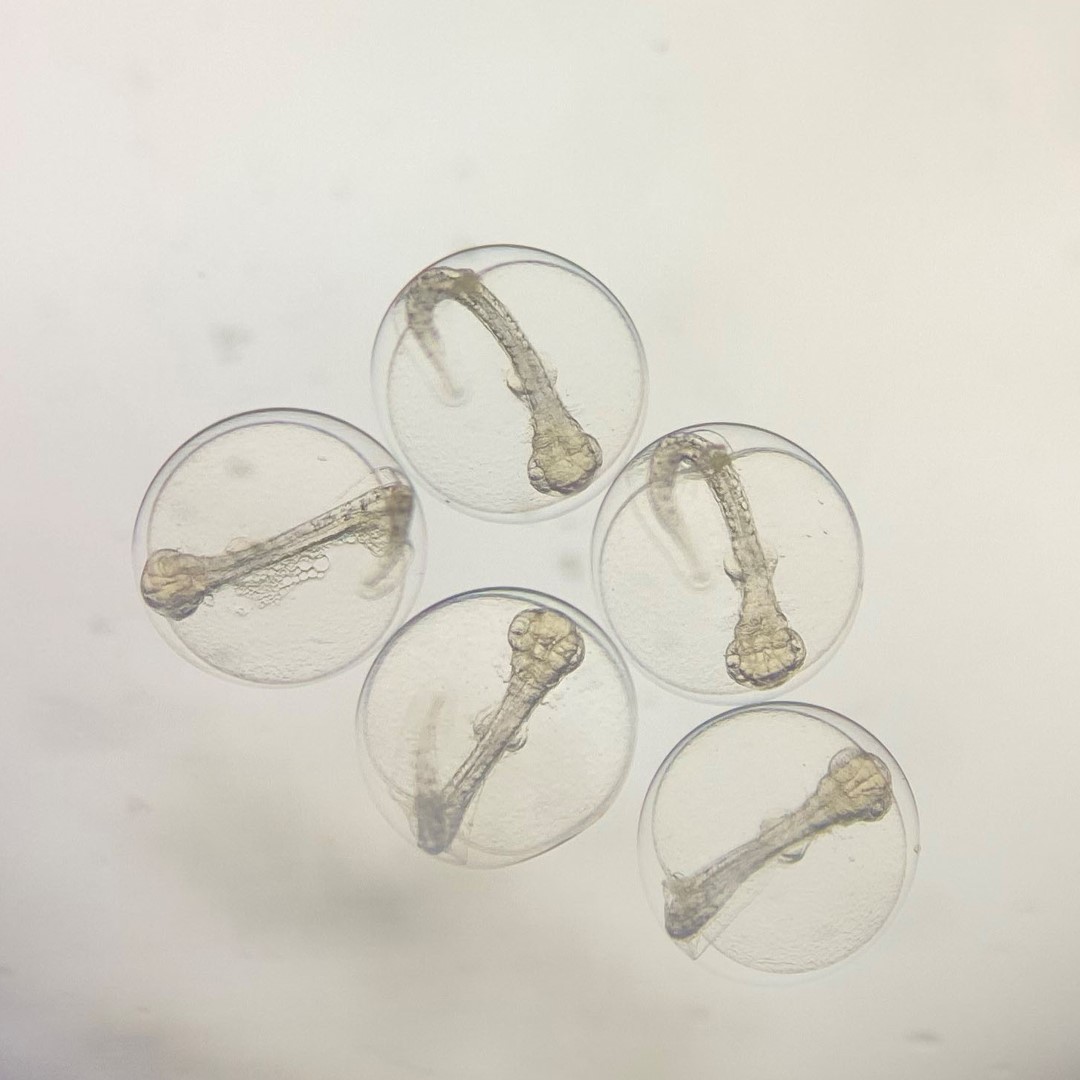During the summer of 2021, Maddi Garate Olaizola started her PhD project within ReCod – release of small cod in the Baltic Sea. With three years behind her, she has worked on several important studies that can contribute with new and valuable knowledge about the Baltic cod. In connection with the PhD programme’s mid-term seminar, we talked to Maddi and summarised what has been achieved so far and what remains in the project.
It has been three years since Maddi Garate Olaizola first stepped onto the Ar research station. Maddi is conducting her PhD project at the Department of Ecology and Genetics at Uppsala University, but it is here on Gotland, where the ReCod project is being conducted, that she has spent most of her time as a PhD student.
In her research, Maddi has studied variations in the size, behaviour and genetics of Baltic cod in their early life stages. In particular, she has focused on how the marine environment affects cod eggs and larvae and their survival through these stages.
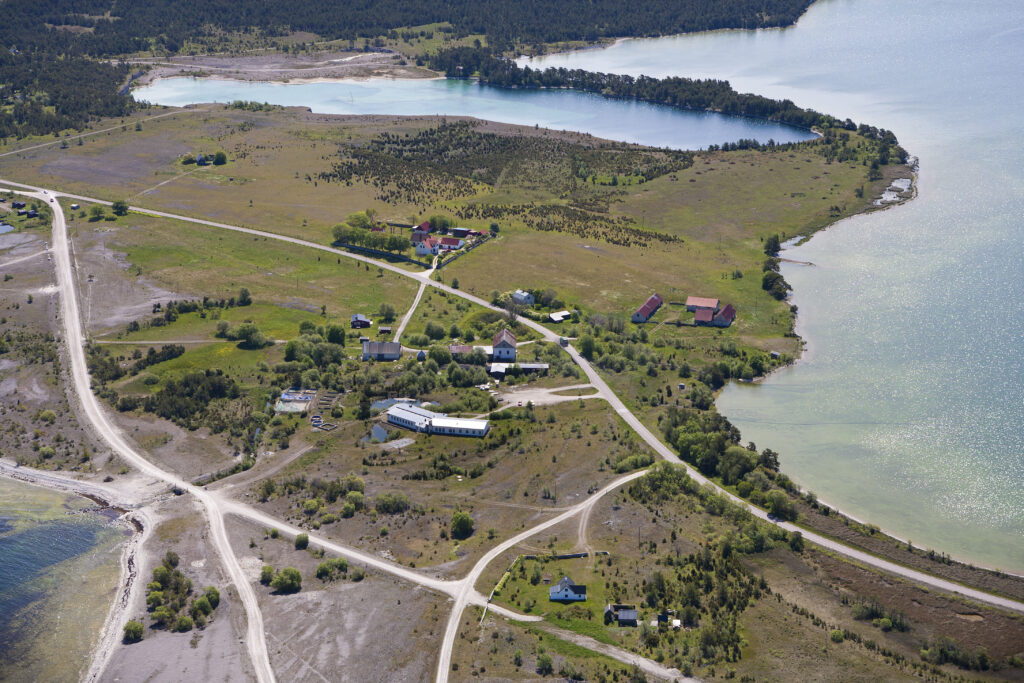
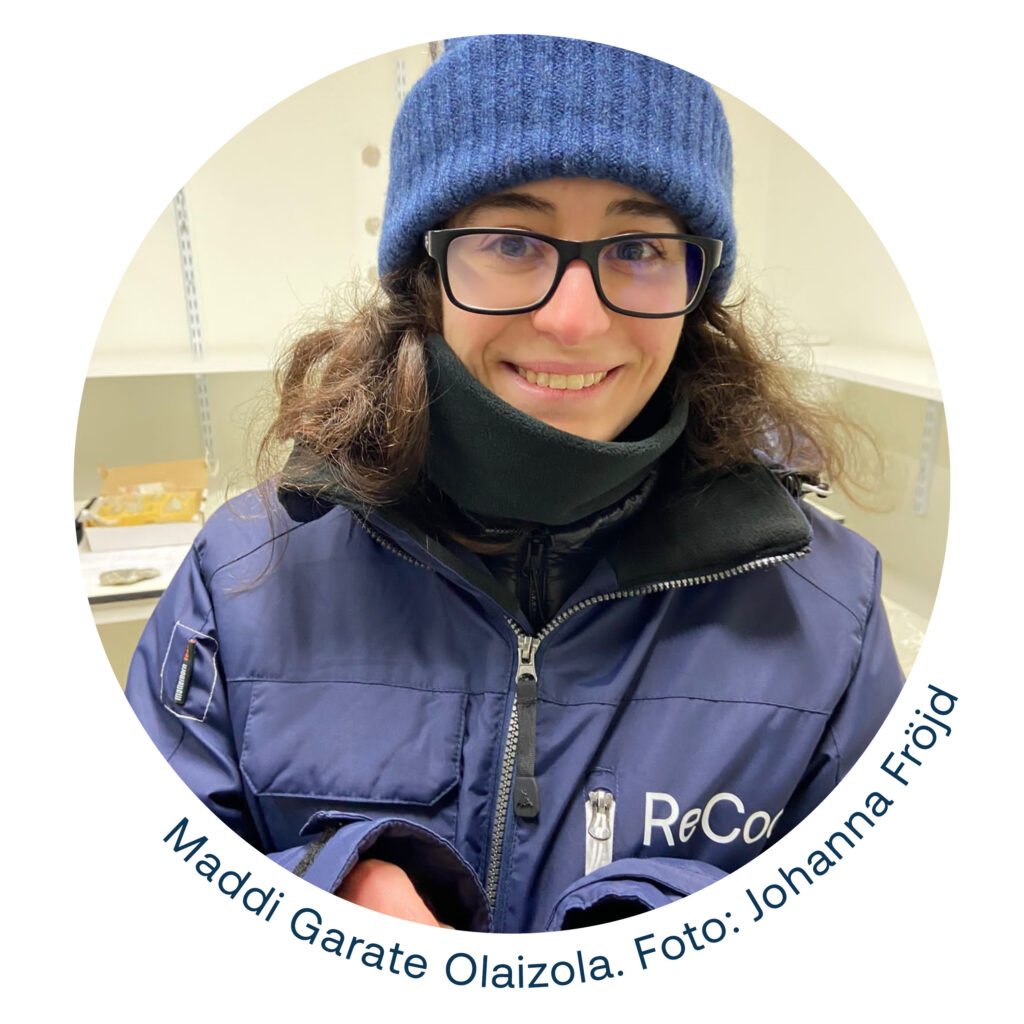
It has been an eventful few years with many experiments and countless hours in the lab. Last week, it was time for her to present what she has done so far in the project, as well as her plan for the rest of her studies, during a half-time seminar.
– But to finally see results and that things are actually working is incredibly rewarding. I am very proud of the work done over the last few years and how much has already been achieved, she says.
– There have been many obstacles and doubts along the way and the the project has changed a lot since the start, says Maddi.
Five studies that provide new knowledge about Baltic cod
As part of her PhD project, Maddi has been working on five separate studies related to ReCod. Much of the work so far has been spent collecting the necessary data through several test fisheries and controlled experiments at the research station on Gotland.
– The final data collection was completed this summer. I have already analysed the results for two of the studies, but for the other three the analysis work starts now, she explains.
– It’s been a long but fun process, says Maddi, who is now looking forward to moving on to the next stage of the project.
Below we present the ongoing scientific studies within Maddi’s PhD project, including their objectives and implementation. The results are currently being analysed, they will be finalised within the next two years and will be published as they become available.
How a changing climate could affect cod larvae in the Baltic Sea
In a first study, Maddi has investigated how changing environmental conditions, due to climate change, affect cod development.
– As a result of global warming, the temperature of the Baltic Sea is expected to rise and salinity to fall. I therefore wanted to investigate how cod eggs and larvae react to these expected changes in the marine environment, says Maddi.

The different life stages of cod. Illustration: Sofie Handberg.
By simulating scenarios with different temperatures and salinities, the effects on hatching, larval survival and buoyancy have been tested. In addition, Maddi has also taken samples for genetic analyses to identify which genes are expressed under such stress. The results are expected to provide valuable insights that are crucial for managing cod stocks under future environmental conditions.
Cod larvae’s preference for salinity and light may control their movement behaviour
When a wild cod larva is 4-6 days old, it starts to feed and swims upwards as food is found higher up in the water column than where the larva naturally floats. Closer to the surface, the environmental conditions are different to where the eggs hatch – it’s brighter and the salinity is lower.
– We know very little about what drives the behaviour of cod larvae, so I wanted to investigate whether these environmental factors drive cod larvae to move up the water column, says Maddi.
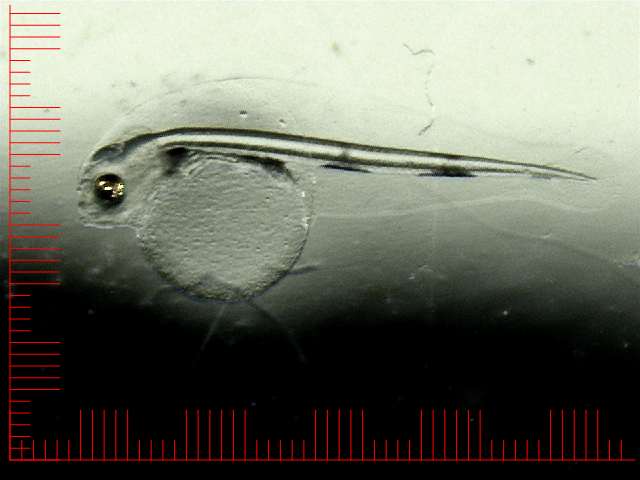
Cod larva. Photo: Maddi Garate Olaizola
To test whether the larvae prefer a brighter environment with lower salinity, Maddi placed cod larvae in tubes with a salinity gradient ranging from 7-17 psu and observed their movement patterns, first in light conditions and then in darkness.
The results of the experiment will contribute to a better understanding of cod larvae behaviour. This knowledge can be used within ReCod to optimise the salt and light conditions when releasing cod larvae into the sea.
The importance of parental fish size for offspring survival and reproduction
Over the past decades, cod in the Baltic Sea have dramatically decreased in size. In light of this, Maddi, together with PhD student Neele Schmidt and laboratory assistant Ramin Eghbal, has been investigating whether the size of the parent fish affects the survival and ability of the offspring to reproduce in different salinities.
– We have done several experiments to test whether larger fish produce eggs with better hatching rates than smaller fish. We also looked at larval size, buoyancy and survival, explains Maddi.
– Buoyancy determines where in the water column the eggs develop and the larvae are located, which affects their chances of survival, she explains.
The results will increase our understanding of whether, and if so how, the reduced size of cod affects fish recruitment in the Baltic Sea. The study can also provide valuable knowledge about the best size of parent fish to keep within the ReCod project.
Maddi in preparation for an experiment. Photo: Madeleine Kullenbo
How cod larvae adapt to Baltic Sea salinity
In another study, Maddi has investigated how cod larvae can adapt from the high salinity of the basins at the research station to the less salty waters of the Baltic Sea. Among other things, the aim was to find out how reduced salinity affects the survival, behaviour and buoyancy of the larvae.
– We exposed the larvae to a decrease in salinity from 17 psu (incubation condition) to 7 psu (sea salinity) and looked at the effects after 2 and 48 hours, says Maddi.
Maddi has also collected samples for genetic analysis to investigate which genes are activated or silenced by a change in salinity, which could provide valuable information on how these genes affect the larvae’s ability to adapt to the new environment.
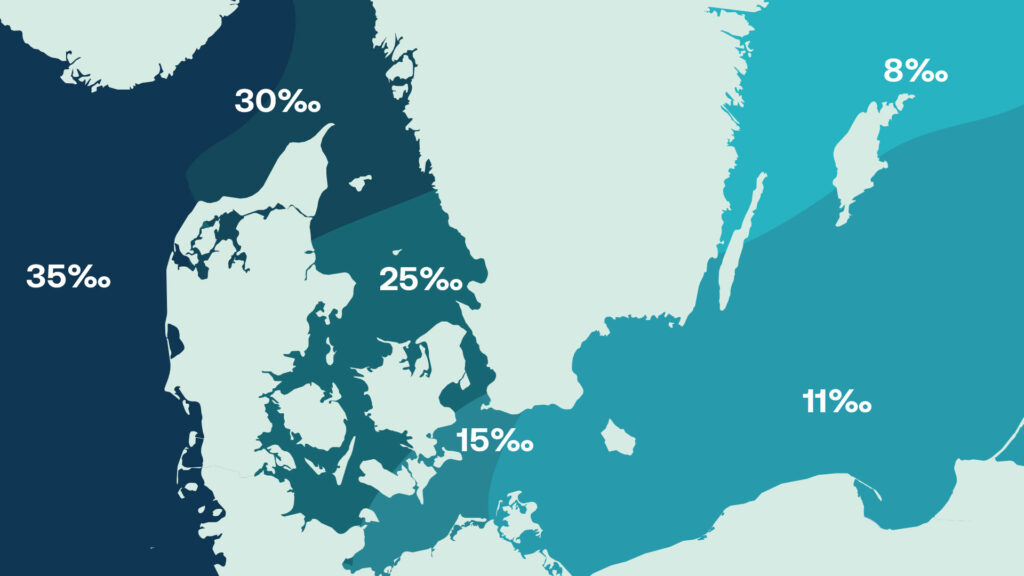
Differences in salinity in different parts of the Baltic Sea, Skagerrak and Kattegat and the North Sea. Salinity in the Baltic Sea is expected to decrease as a result of climate change – increased precipitation and river runoff will bring more freshwater, while the inflow of saltwater from the North Sea is expected to decrease.
Is the Åland cod divergent from the Bornholm cod?

Maddi in the lab. Photo: Madeleine Kullenbo
While cod stocks in much of the Baltic Sea have declined sharply, cod in the Åland Sea are both larger and more viable. It has previously been assumed that the Bornholm Deep is the only place where Baltic cod can spawn successfully, and that cod eggs cannot survive in the Åland Sea due to the significantly lower salinity – yet the issue remains scientifically unexplored.
– Åland cod are present in the Åland Sea during the spawning season, but we still don’t know if they can reproduce there, explains Maddi.
In the final study of the project, Maddi will investigate whether fish caught in the Åland Sea have a higher tolerance to low salinity than fish caught in the southern Baltic Sea. She will also test whether the eggs can survive at lower salinities, in which the eggs sink to the bottom.
Analyses and results – for the long-term management of Baltic cod
With the mid-term seminar behind her, Maddi is now entering the final phase of her PhD project. There are a couple of years of intensive analyses ahead before the results are ready, but Maddi is already looking forward to sharing the new knowledge.
– Much of the new knowledge will be directly applicable within ReCod but also provide important insights that can be used in the long-term management of Baltic cod, she adds.
– I hope that my results will contribute to a deeper understanding of Baltic cod, especially their early life stages, which are very unexplored – both in cod and fish in general, says Maddi.
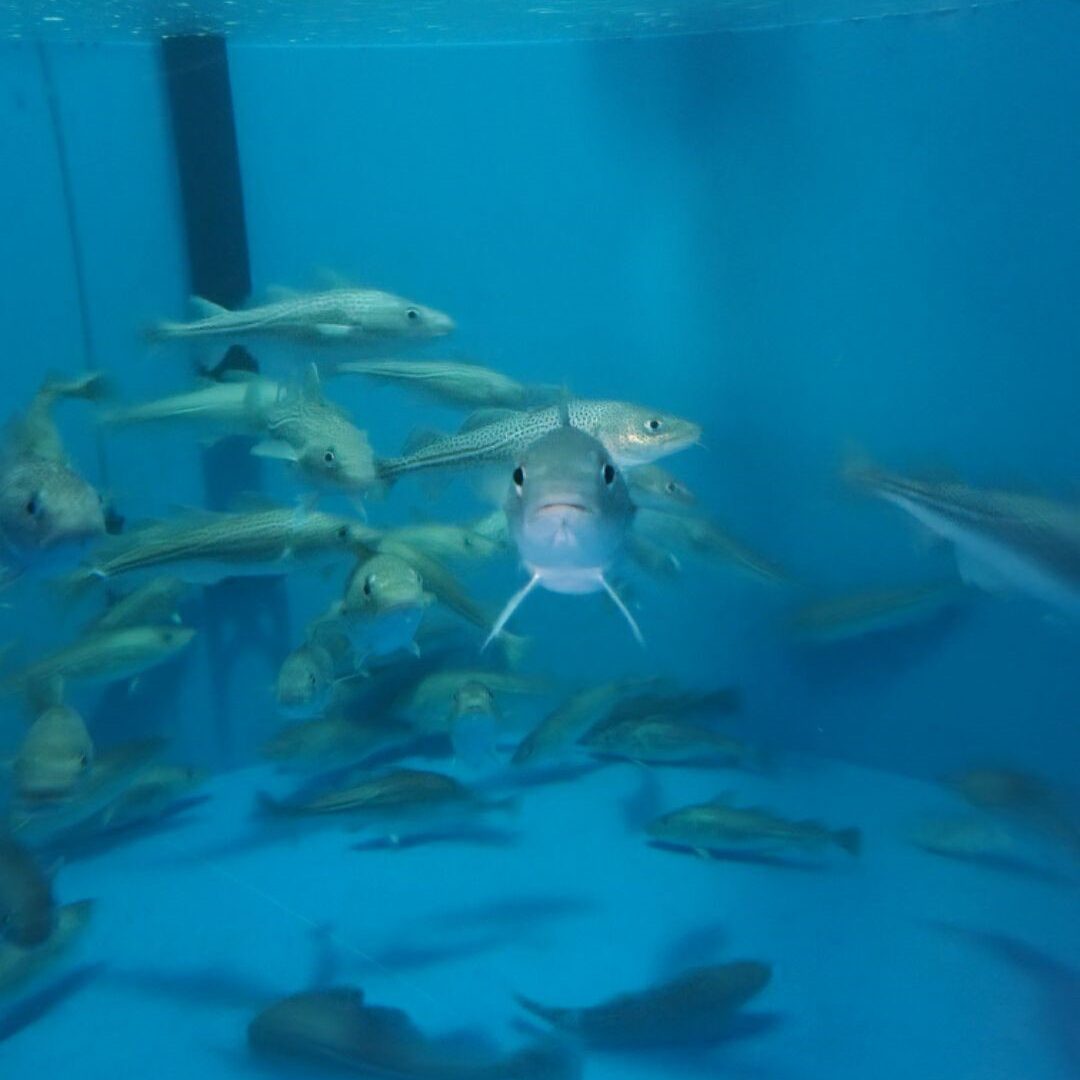
Cod in one of the pools at Ar research station. Photo: Johanna Fröjd.
We wish Maddi the best of luck with the final part of her PhD project and look forward to many exciting results ahead!

About ReCod
Since 2021, the project has been carried out at the Ar research station on Gotland – in the middle of the Baltic Sea. The goal of ReCod is to conduct trials with releases of 4-6 day old cod larvae at a few locations along the east coast where we investigate whether the larvae survive and manage to establish themselves. If the trials are successful, there is the possibility of re-establishing cod in the Baltic Sea in more places, which increases the chances of preserving and protecting the unique eastern stock. ReCod is implemented and funded by BalticWaters and Uppsala University. In addition, a number of partners are contributing to the project in various ways: Leader Gute, Region Gotland, the Swedish University of Agricultural Sciences and the Ulla and Curt Nicolin Foundation. In total, just over SEK 50 million is being invested in the project.
From 2025, the ReCod project will be run at BalticWater’s new fish research laboratory being built outside Nyköping.
